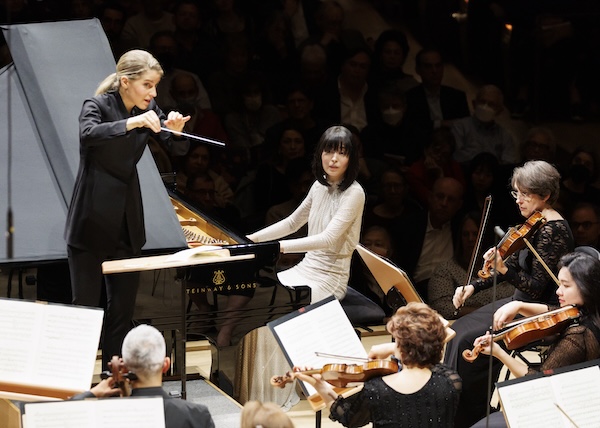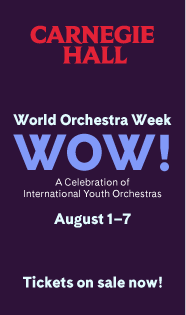Ott’s Ravel provides a musical memory to treasure with Philharmonic

Thursday night’s New York Philharmonic concert featured a pair of debuts with the orchestra, and also a paired argument. The former was intentional—the first David Geffen Hall appearances of guest conductor Karina Canellakis and pianist Alice Sara Ott. The same is true for the program of Webern, Strauss, Ravel, and Scriabin. But one wondered if the argument implicated in the music was understood, or ever seen ahead of time.
The concert opened with Webern’s Six Pieces for Orchestra (in the 1929 revision) and Strauss’ Tod and Verklärung on the first half, then Ravel’s Piano Concerto in G Major and Scriabin’s Le Poème de l’extase for the second. On paper, that’s all music that puts orchestral color and balance at the forefront, and the Philharmonic brought out the details of each composer’s ideas to fine and impressive degree. But this is also music facing off across a vast gap of styles and values, that’s exactly what the expressive and intellectual ideas sounded like—and made fully clear through the orchestra’s performance.
For someone who cares about the music, its place in history and its aesthetic and social purpose, this was a valuable experience. The playing was focused and full of energy and in many ways put the pieces in their best light.
One cannot think of two composers more diametrically opposed than Webern and Strauss. Six Pieces is form in the leanest, most objective, and atomized sense, while Strauss’ tone poem is lush and verbose, one piece that’s three times as long as Webern’s six combined. The difference is much deeper, though going to the very nature of music. There’s an expressive purpose to each: Webern was burdened by the death of his mother, but his manner meant working out his feelings internally, the music coming off as beguiling but hermetic gestures through which the listener can discover their own feelings. Strauss’ narrative is dramatic and specific, his music tells us what we should be feeling.
Each performance was strong. In the Six Pieces, the orchestra’s patience and attention to instrumental timbre was superb, the musicians taking the briefest lyrical phrases and filling them with expressive weight. Colors were bright in Strauss, the strings playing with a sound that was both delicate and substantial. Canellakis’ precision in the Six Pieces was impressive, as was the pace in Tod and Verklärung. If one was fully absorbed by Webern’s infinite possibilities and left cold by Strauss’ declamatory statements, that had more to do with the works themselves than the performances.
Because of the nature of the classical music business, Ott is probably more well known for both playing barefoot and a diagnosis of multiple sclerosis. This has not affected her playing, which was absolutely wonderful, one of the finest concerto performances one has ever heard.
She and the orchestra not only played at an extremely high level of technique and artistry, but with an interaction and responsiveness one rarely witnesses. The orchestra supplied equally engaged support especially the woodwind section.
Ott didn’t just have the hands for the music, running through the most demanding passages in the first movement with fiendish dexterity. She had such command of the music that one had the feeling that rather than playing a concerto, she was playing Ravel—his ideas and style, his sense of fun and beauty. And even in the fast opening and closing movements, Ott played with an extraordinary sense of beauty, relishing the harmonies and getting a luscious, singing legato out of the piano while still articulating each note.
The Adagio assai movement was breathtaking. Ott played slightly behind the beat, giving a feeling of a gentle lingering on each phase. The brief solo statement from harpist Nancy Allen was sublime, and the movement reached a ravishing high point toward the end, with Ott pushing and pulling at the tempo of the scales under gorgeous playing from English hornist Ryan Roberts. It was one of the most beautiful things one has ever heard in any concert hall.
Unfortunately, it did have to end, because the final movement came. After this special performance, Ott obliged the ovations with Satie’s Gnoissiennes No. 1. It was perhaps a little indulgent, but who could begrudge her anything?
Scriabin’s ecstatic tone poem just could not match this. As colorful, it not more, than Ravel, it again is music that works hard at telling the listener what its about, rather than giving space for one’s own thoughts—the difference between and invitation and a lecture. One could not find the mood to get much out of the lecture, even with the muscular performance from the orchestra. If it didn’t have that special Scriabin perfume, it was technically brilliant and physically exciting.
This program will be repeated 8 p.m. Saturday. nyphil.org
